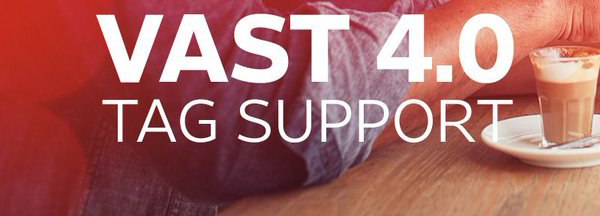What does VAST stand for?
VAST stands for Video Ad Serving Template.
What are VAST Tags?
Essentially, a VAST tag is a third-party ad tag that’s generated by an ad server, specifically for video ads. VAST tags enable video players to sync with ad servers. That way, as an advertiser, you have the ability to serve ads into multiple ad inventories within video ad players. Put simply, VAST tags enable your video ads to display correctly on video players, across various publishers and ad networks.
Why are VAST Tags important?
VAST tags are important because they allow video players and ad servers to speak the same language, essentially. Standards equal scale, AKA more volume for publishers to sell and more revenue generated.
What is the main idea behind VAST Tags?
According to Eric Boyd, the director at JW Player, “The idea behind VAST is to avoid forcing a publisher to change its video stack just to use different ad servers.”
Benefits to using a VAST Tag Inspector / Validator
VAST Tag inspectors check whether your video ad response will work with the IMA SDK. Simply paste your VAST ad tag or VAST ad response into the text field provided and submit it.
Why Validate?
Why do Web Professionals choose to validate?
Validation as a debugging tool
Modern day Web browsers are doing an increasingly good job of parsing some of the worst HTML “tag soup”, but some errors are not caught. Various software on different platforms may not handle errors in the same fashion, making it extremely difficult to apply layout or style consistently.
By using VAST standard, you have a much greater chance of having your Web page handled consistently across various platforms and user-agents.
A recent survey conveyed that the majority of Web professionals state that validation errors is the first thing they will check whenever they run into a Web styling or scripting bug.
Validation as a future-proof & quality check
By checking that a Web page displays correctly in several contemporary browsers is a reasonable insurance that the page will “work” today, but it doesn’t always guarantee that it will “work” tomorrow.
Validation is one of the most simple way of checking whether a page is built in accordance with Web standards. Additionally, it provides one of the most reliable promises that future Web platforms will handle it as originally designed.
Validation eases a lot of maintenance
Just as it is reasonable to consider standards such as HTML and CSS are both forms of “coding style”, creating Web pages and applications according to a widely accepted coding style makes them much easier to maintain.
Validation helps develop good practices
Web Professionals say they have been using HTML and CSS for years, and know these technologies by heart. On the other hand, beginners and students may find automated checking tools invaluable in spotting any mistakes. Most teachers stress that automated validation tests provide great introduction to broader, more complex quality concepts like accessibility.
Validation is a key sign of professionalism
Validation is used as a quick check in order to determine whether or not the code marked up by a Web Professional is of clean work, or a quick, mashed-together form of “tag soup”.
Frequently Asked Questions
“My side works fine and looks just right – isn’t that enough?”
In short – no.
Markup languages are no more than data formats. Therefore, different browsers can, and will, display the same page very differently. The only way to guarantee that your Web page looks the same across all platforms, is to validate it.
“Many websites out there don’t validate – including some household-name companies.”
Fact: Household-name brands/companies expect people to visit their site because of their name, and in spite of their dreadful websites. Do you have a big enough name-brand to afford that luxury?
Even if you can, is it worth the risk of being on the wrong side of a lawsuit due to the fact that your website may prove inaccessible to – for instance – a disabled person who cannot use a ‘conventional’ Web browser? While validation does not guarantee accessibility on all fronts, it is the best tool available for this cause.
“I hear validation means boring websites – and it prevents creativity.”
They may have been the case a decade ago. However, in this day and age, validation has nothing to do with your websites design and creativity opportunities.
Integrating a VAST Tag
In order to integrate a VAST tag to your ad server, your ad server must send XML that conforms to the IAB specifications for the supported versions of VAST. You can use our VAST Inspector to ensure that these tags are formed correctly.
Start by making sure that your ad server’s VAST response contains IAB compliant TrackingEvent elements, and standard event types, such as impressions. If you do not include standard tracking events, it is possible that your VAST response will be rejected, and it will not provide an ad fill for the break.
VAST versions 3.0 and newer support ad pods, which deliver a set of sequential linear ads. If a specific ad in an ad pod is unavailable, you will receive an error. In a case like this, you will need to find a different ad pod that can be used.
Benefits of VAST for Operations
How can VAST Tags benefit operations? Let’s go over some of the benefits:
- When you have a working VAST tag, you can plug your ad into your ad server, and it will always work. As long as you and your providers are following the baseline format of the VAST standard, that is.
- You will save a lot of time, as you will no longer have to schedule your video ads into the format known only to your video player. In addition, you do not need to be an Adobe Certified Flash programmer to schedule your video ads and have them display correctly.
- If you hire anyone new, you won’t have to spend the time teaching them how to book custom ads anymore.
- It will consolidate your operations process by not only simplifying your own ad delivery, but will also allow you to serve ads from other providers without any overhaul to your video player.
- If you have video player developers, they will thank you for simplifying their duties. On that same note, your developers will no longer have to spend extensive hours developing cycles and customizing the video player for each new ad network or third party that you want to run.
How do VAST Tags simplify the process?
Non-linear ads are tricky, which is a major reason they are so great. They are not just images and video files, they are composed of many components, similar to little mini-applications running inside your big video player application.
VAST was not created to tell the video player how to handle those types of ads. Rather, VAST simply tells the player that there is an ad to be displayed, here is the link to the ad, and how long the ad should play for. To avoid complication, VAST tags do not give video players any information about special interactivities – like what to do when you expand an overlay over video or when a person clicks to interact with a game inside a takeover. So, video players will still require custom programming to handle those special ads, sort of like a web page does for rich media.
Difference Between VAST URL and VAST XML
VAST tags come in two different formats. Those include VAST URL and VAST XML. It is important to know the differences between the two.
The only way to determine which type of VAST tag you can generate, solely depends on the DSP you are using. Certain DSPs only accept VAST URL tags. Others accept both VAST URL and VAST XML tags. If your DSP supports both formats, then VAST XML is absolutely the preferred method.
Additional Points to Consider
So, VAST has been around since 2008. What’s changed since then? Have improvements been made?
The amazing thing about VAST, is that it has grown over the years alongside (or in response to) the demands of publishers and advertisers. Newer versions allow video players to signal which ad formats they want – whether linear, non-linear, linear skippable, etc. That specific improvement was a big deal for publishers who wanted to play certain formats, and not others.
Does all of this have anything to do with the viewability issue I continue to hear about?
There’s been talk of “viewability issues” within the video advertising industry for a while now. One of the big limitations VAST has, is that it did not support all viewability standards until VAST 4.0 was released. As a result, the industry had to mash together a solution, known as VPAID. The good news? VAST 4.0, and newly released 4.1, both address these issues.
HOLD UP! What’s VPAID?
VPAID stands for Video Player Ad-Serving Interface Definition. VPAID, to put it simply, is code that runs within video players. This code is what “spices up” a typical toothpaste ad, and makes it an interactive one. In addition, VPAID helps give advertisers more information about how ads are actually performing.
Benefits of VPAID creatives:
- Allows for interactive elements in video ads, within a video player.
- The ad updates the video player once it is finished playing, so that the player can resume the video content where it was cut off.
- Allows the ad to request that the video player pause the content, should the viewer interact with the ad.
- Features the ability for the video player to override an ad, if/when it takes too long to load.
- Allows for ad resizing.
Is VAST desktop focused? What about mobile?
When VAST and VPAID were first developed, we were in a pre-mobile, pre-app world. Due to that fact, IAB developed MRAID (Mobile Rich Media Ad Interface Definitions), a standard for rich-media ads that run in mobile apps. Additionally, IAB updated MRAID standards so that they now incorporate some of VPAID’s functionality.
As an Advertiser, Do I have to build my own Ad Server?
The answer is… nope! As an Advertiser, your best bet is to simply select a reliable third-party Ad Server that supports VAST. A great Ad Server will provide you will detailed reports, audits, and split-testing tools.



